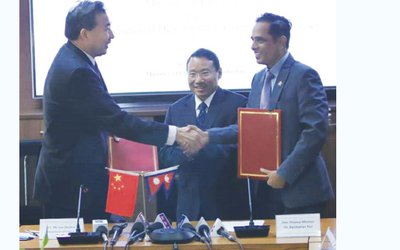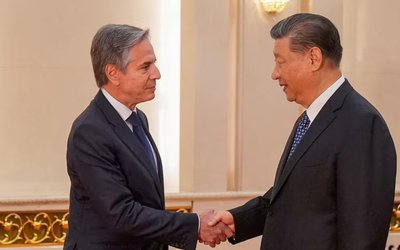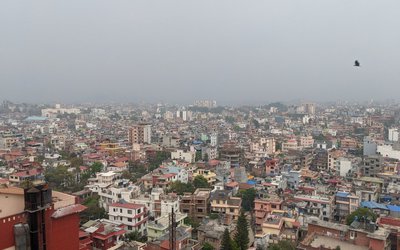Reliable water and energy supplies are a sine qua non for any self-respecting country hoping to achieve economic prosperity. Unfortunately, in Nepal thanks to myopic political leadership within each major party that cannot think beyond the welfare of its coterie, both these sectors are in a dismal state. To expect the current dispensation to improve utility supplies, when it could not carry out the main task of drafting a new constitution, would be naiveté. But some reflection is due so as to understand the undercurrent dynamics that will roil the water sector in the years to come from the inactions or mal-actions of Nepal's new political masters.
For a country with no parliament, no constitution and no legitimate government either national or local, it is strange that things do run. No one has really died of thirst as yet, nor is it impossible to charge mobiles and inverters in the hours the utility does provide electricity. The fact that a total breakdown has not occurred is a tribute to the middle and lower ranks of Nepal's bureaucracy that plods on tinkering and muddling through with the basic minimum they are authorized to handle. At the higher echelons, however, the vacuum left by political dysfunction is being filled, unfortunately, one must add, by international busybodies. Fortunately this intrusion is being countered by an assertive younger bureaucracy in quite a few instances. The machine-readable passport case was one positive example. Another has been the Nepali hydrocracy’s reaction to the World Bank's Ganges Basin Strategic Assessment report.
The Ganga basin, shared by Bangladesh, India, Nepal and China, has a long history of well-meaning attempts to foster regional cooperation with an equally long list of studies littering the landscape as graveyard tombstones. The first was Harvard University's attempt in the early 1960s followed by UK's then ODA in the Kosi basin. They collapsed due to Mrs Indira Gandhi's paranoia in the wake of the 1965 Tashkent agreement. Ford Foundation was next with its Ganges-Brahmaputra-Meghna attempt that produced a few books bemoaning the lack of regional cooperation to harness the basin's massive potential. The ADB's “growth quadrangle” too went nowhere, and neither did the Canadian/World Bank/Bechtel 18-volume, 15 million dollar study on the Karnali-Chisapani in the late1980s. The latest addition to the graveyard is the World Bank's Strategic Assessment. All have crashed against an immovable mass: Delhi hydrocracy's strict bilateralism that does not allow any regional cooperation in water, its ludicrous data secrecy and its refusal to even admit that regulated water from dams in Nepal has massive multipurpose, non-power downstream benefits, leave aside trying to share those benefits equitably.
The Strategic Assessment was done under the aegis of what is called South Asia Water Initiative (SAWI), a consortium of donors led by the World Bank with well-meaning UK, Norwegians and Australians in tow. It was supposed to have been “owned” by what is called the Abu Dhabi Dialogue (ADD), a process begun in 2006 primarily by UK's International Institute for Strategic Studies but later taken over by the World Bank. It involved senior members of government and opinion makers of countries sharing rivers of the Greater Himalaya engaging in dialogue to promote cooperation in developing the region's waters. Five dialogues were held till 2010 but somewhere along the way, the Bank decided to morph it all into a Track 1 process keeping even the ADD members in the dark, and simultaneously doing a 'strategic assessment', all the while neither informing the government (at least of Nepal) nor opinion makers in the country. A presentation was made after the assessment's completion where the study was criticized severely by government and non-government experts for untenable assumptions; but these criticisms were totally ignored and the report disseminated in Sweden and later to the government. (ADD members have not been given this report by the Bank, nor were they consulted as Bank experts unilaterally went about doing their work.)
It is this strategic report that has recently been torn to shreds by the younger hydrocrats in Nepal. A meeting called by the Ministry of Irrigation on 1st July fired the first official salvo, and another meeting, on 20th July that was chaired by the doyen of Nepal's retired water officials Karna Dhoj Adhikari, saw Nepal's present and past officials as well as water experts united in their rejection of the Strategic Assessment.
What was so bad in the report? But before that, what so good that the advisor to PM Baburam, the colourful Mr Rameshwar Khanal, was seduced into praising it publicly, even though he is no water expert? It is indeed so lucidly well written busy policy makers can easily succumb to its charms. Unfortunately, that does not hide its flaws when experts look at it, which is what happened when Nepali hydrocrats started going through it with a fine comb. On the technical side, its models use Nepal's open data, fail to get any Indian data, and project mountain hydrological conditions onto the overall basin plains right down to Bangladesh, without assessing the plains at all. It ignores major studies of the past such as that funded by the Bank itself on Karnali, incorrectly assesses the status of groundwater and its hydrology, fails on sediments completely, whether for storage or in the embanked plains, and ignores the very basics of integrated water resources management that was promoted by the Bank in the past. It then jumps to conclusions that are questionable, especially from a political-economic angle.
It concludes that building dams in Nepal (drowning Nepali villages) has negligible flood control benefits for the basin as a whole claiming also that all of Bihar and UP have been embanked, ignoring the fact that in the immediate riparian downstream the medium-term benefits are big. It also downplays the massive irrigation, navigation and other benefits from doubling or even quadrupling downstream dry season flow by the contradictory argument that agriculture productivity in UP and Bihar are low and hence there are no irrigation benefits. Any undergraduate agriculture economist would have argued to the contrary, that in a land-rich and water scarce region such as the northern Gangatic plains, providing double dry season flow would double irrigated area and even cropping intensity! Nepal’s Agriculture Perspective Plan funded by donors like ADB says that 27% of overall irrigated agriculture’s productivity is due to water availability, and in India’s Tehri dam, power is only 40% of the benefits while irrigation accounts for 60%. The World Bank’s study ignores it all. It thus overvalues hydropower export, ignoring the fact that projects like SMEC’s West Seti collapsed after some 14 years of effort because Delhi hydrocracy was forcing the price of electricity from Nepal to below market rates, levying import surcharge and raking in billions in rent while Nepal would get measly millions from royalties.
Hence the primary conclusion of the Strategic Assessment – that Nepal forget about multipurpose projects (and the irrigation, flood control, navigation as well as other benefits associated with them) and go immediately for agreements with India on hydropower export only – had our young hydrocrats and experts all riled up. In their minds the World Bank had surrendered to Delhi hydrocracy’s neo-colonial resource exploitation model and was no longer the reliable partner it once was. It was a sad day hearing it; but to be fair to the World Bank, if our own political masters a la S. D. Muni’s latest exposé have long so surrendered, why blame the Bank for following their lead?
- TANAHU HYDROPOWER PROEJCT: A Significant Achievement
- Apr 15, 2024
- AMBASSADOR HANAN GODAR: Sharing Pain With A Nepali Family
- Mar 30, 2024
- VISIT OF KfW AND EIB TO NEPAL : Mission Matters
- Mar 25, 2024
- NEPAL BRITAIN SOCIETY: Pratima Pande's Leadership
- Mar 24, 2024
- NEPAL ARMY DAY: Time To Recall Glory
- Mar 15, 2024















